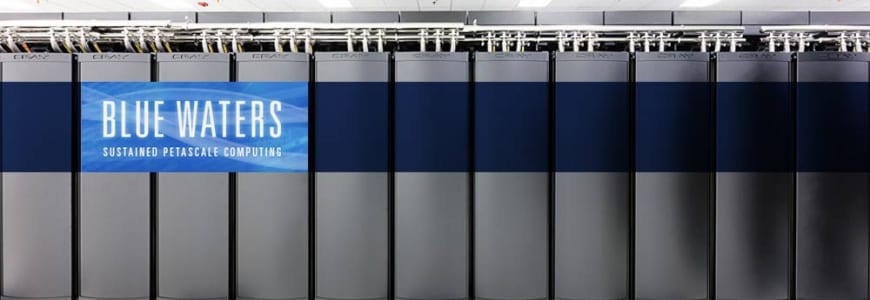By Rob Mitchum // March 29, 2013
THE ILLINOIS SUPERCOMPUTER NEIGHBORHOOD GROWS
On Thursday, the National Center for Supercomputing Applications at the University of Illinois celebrated the full launch of Blue Waters, their new one-petaflop supercomputer. As part of the ceremony, Governor Pat Quinn declared “Blue Waters Supercomputer Day,” and Senator Dick Durbin saluted the machine and other supercomputers as “the gateway to next-generation research.” The start of 24/7 research was also a proud day for Computation Institute scientists such as Michael Wilde and Daniel Katz, who were involved in getting Blue Waters up and running. Wilde spoke about the supercomputer at the CI’s Petascale Day event last October.
Meanwhile, a couple hundred miles north of Blue Waters, Argonne’s new 10-petaflop supercomputer Mira nears the start of its own full production period later this year. This week, the laboratory released a new timelapse video of the machine’s construction, which you can watch below. But science isn’t waiting for Mira to reach full strength, as demonstrated by this new project on the combustion and detonation of hydrogen-oxygen mixtures — a potential alternative source of fuel.
THE GRAND MOTHER OF CLOUD
In recent years, cloud computing has crossed over from inside baseball IT chatter to the general public. As CI fellow Rob Gardner recently charted, web searches for the term began climbing in 2009 and still vastly out-pace searches for similar buzzwordy topics such as “big data” and “virtualization.” Now that consumers are comfortable with storing files and running programs in the cloud, it’s time for the pioneers of that technology to take their victory laps. One recent round-up of cloud computing mavericks at Forbes tagged CI fellow Kate Keahey as “the grand mother of cloud,” recognizing her early work on infrastructure-as-a-service (Iaas) platforms. Her current project, Nimbus, is dedicated to providing cloud-based infrastructure for scientific laboratories.
OTHER NEWS IN COMPUTATIONAL SCIENCE
A lot of what we know about science may be wrong, but finding those flaws could lead to better discovery in the future. That’s how this article on Txchnologist framed the new Metaknowledge Network led by CI fellow James Evans. “We’re building on decades of this deep work on science and trying to connect it to this computational moment…to get a quantitative understanding of why we have the knowledge we have,” Evans told reporter Rebecca Ruiz.
The open release of data by the city of Chicago hasn’t just improved our understanding of how the city works, but also how we see it. These beautiful visualizations created with the Edifice software (one of the projects at the Open City collaborative) make the neighborhoods of Chicago look like a genomic SNP chip…or an elaborate Lite Brite project.
Many Chicago homes would benefit from improvements that improve energy efficiency, saving them a huge portion of their monthly utility bills. But many residents are unaware of the option or unwilling to bear the up-front expenses needed to retrofit homes to reduce energy usage. According to WBEZ, two University of Chicago students have founded a new startup called Effortless Energy that uses data-mining techniques to both locate and assist these opportunities for conservation and savings.
The “traveling salesman problem” of finding the most efficient route between 20 different cities has long frustrated mathematicians. So English scientists created “programmable goo” to find the shortest route in similar fashion to studies that have used slime mold as navigators. You can read the paper, “Computation of the Traveling Salesman Problem by a Shrinking Blob” at arXiv.

